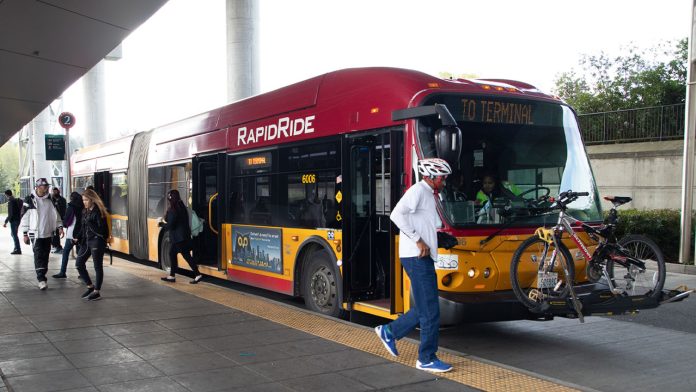
After spending years on the back burner, work to advance King County Metro’s next RapidRide line on the Eastside is coming back into the public eye. The K Line is planned to connect Kirkland with Bellevue, providing connections to some of the region’s fastest growing neighborhoods and bringing thousands of transit riders quicker access to Sound Transit’s light rail and Stride bus rapid transit (BRT) stations.
RapidRide K had been heading toward a 2025 grand opening before the Covid-19 pandemic’s initial impact on Metro’s budget derailed planning work. Now King County doesn’t expect the line to open before 2030. Even as the date of launch remains far in the future, Metro intends to make critical decisions on the K Line this year, including where bus priority will be added and where pedestrian improvements will be made along the route.
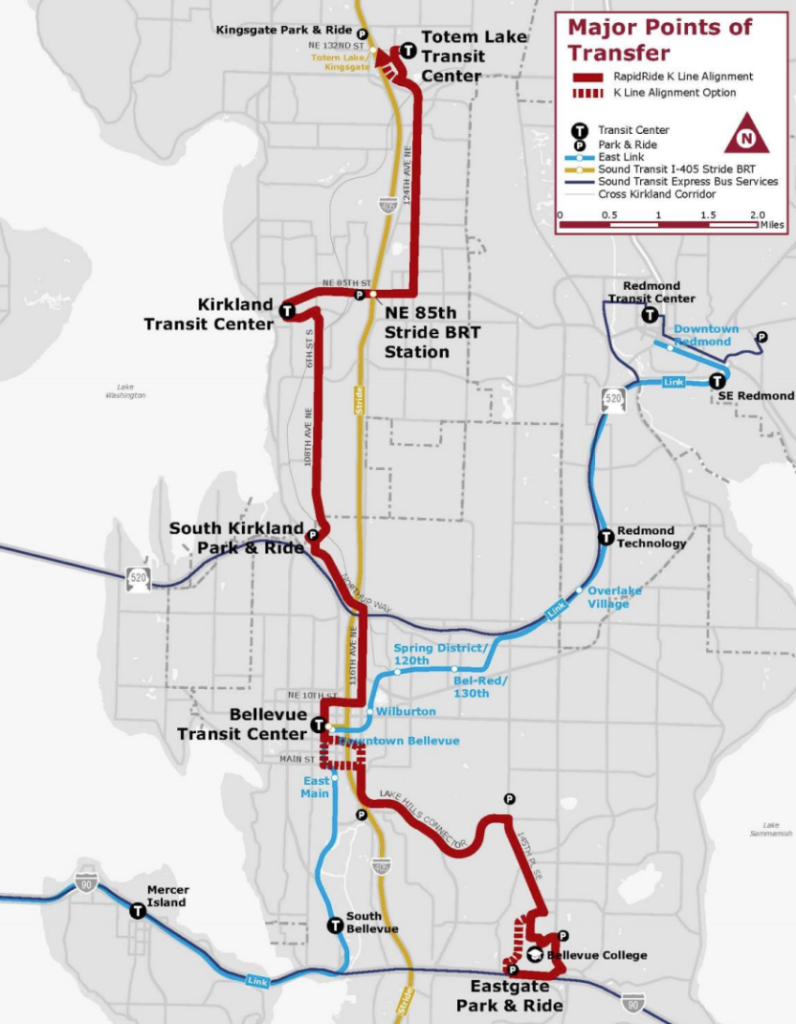
With the restart of work, King County is working toward selecting a “locally preferred alternative” by the end of the year that will head to the King County Council in early 2025. That will coincide with the official submission of a grant application to the Federal Transit Administration (FTA), via the Small Starts program that has funded other RapidRide lines around the region in recent years. The total cost for the project isn’t yet clear, but an estimate from last year pegged it at $120 million.
Earlier this month, the Bellevue City Council gave its approval to a set of “guiding principles” that city staff will attempt to follow as it advances the K Line’s design on the local level. That follows approval of a letter of support approved by the Kirkland City Council in early May. When it comes to RapidRide upgrades, much depends on the local jurisdiction moving things forward and approving bus lanes and sidewalk expansions.
In walking back its ambitious Bike Bellevue safety and mobility plan in March, the Bellevue City Council signaled an unwillingness to sign off on reallocating street space along some of the same streets where the K Line will run, directing its transportation commission to look at alternate proposals for 11 planned corridor projects. Now transit advocates are watching to see how this direction might play out when it comes to the K Line. The B line between Bellevue and Redmond, Metro’s first RapidRide on the Eastside that opened in 2011, mostly operates in mixed traffic and includes very little dedicated right-of-way.
The Bellevue City Council did give additional direction that the guiding principles should lead the city toward “reliable and consistent” service — a change requested during the public comment period by advocates like Christopher Randels of Complete Streets Bellevue — but implementation of that will be put to the test in the coming months, with another potential fight over reallocating street space in Bellevue on the horizon.
Downtown Bellevue routing remains TBD
One big open question that will weigh heavily in the usefulness of the K Line is the routing and station locations through Downtown Bellevue. A number of options are on the table, including crossing I-405 at SE 8th Street to directly serve the East Main light rail station or heading directly into downtown via Main Street.

Slides from an internal presentation Metro gave to City of Bellevue staff in February stated a preference among City staff for the Main Street crossing, noting it serves a portion of the Wilburton growth center and that the street has lower traffic volumes than SE 8th Street.
A Main Street route would likely mean the route would never gets to Downtown Bellevue Station’s doorstep, a major transfer point for Kirkland residents trying to access 2 Line light rail. The presentation noted concerns with “operations and siting of stations” along 110th Avenue NE at the station’s front door, and expressed a preference for 108th Avenue NE, on the other side of Bellevue Transit Center. “108th Ave NE is currently a major transit street and is identified as a transit corridor in the Comp Plan,” Metro’s presentation stated.
If the 110th Avenue NE alignment moves forward, County staff look to be proposing converting a lane in each direction to transit-only between NE 10th Street and NE 6th Street, but received some words of caution on that from Bellevue staff as well. “Removing parking could be contentious and work against some curbside management goals the city has over the coming years,” was the city response to that idea as noted, along with a question of whether dedicated priority would really be necessary between NE 10th and NE 8th Street.

Which isn’t to say that City of Bellevue is pushing back on transit priority along the entire line. The idea of transit lanes across I-405 along Main Street was greeted positively. If the routing along 112th Avenue NE were to move forward, there was support for transit lanes there as well. But Bellevue business interests that have come out swinging against attempts to reduce general purpose vehicles capacity in the past can likely be expected to push back vociferously again in this instance.
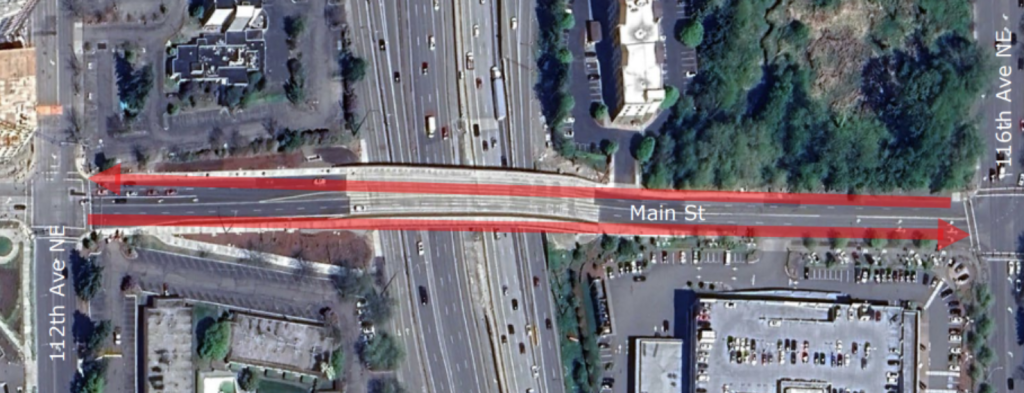
Elsewhere on the route, queue jumps that allow buses to get a head start are proposed in spots like Northup Way where they have the potential to benefit many more routes than just the K Line. In the coming months, the exact scope of these proposed improvements will come into view.
Fewer decisions to make in Kirkland
The routing for the K Line in Kirkland is largely baked in right now, with the biggest question what path the K Line will take to get to its northern terminus in Totem Lake. Kirkland’s Totem Lake neighborhood has been transformed over the past decade. The Village at Totem Lake shopping center now includes hundreds of new homes, with newly remade internal streets intended to prioritize pedestrian traffic. However, after the overhaul, buses don’t serve 120th Avenue NE because the relatively narrow design of the street makes it hard for a bus to navigate, particularly when motorists park carelessly, jutting into the street, which is common given the layout.
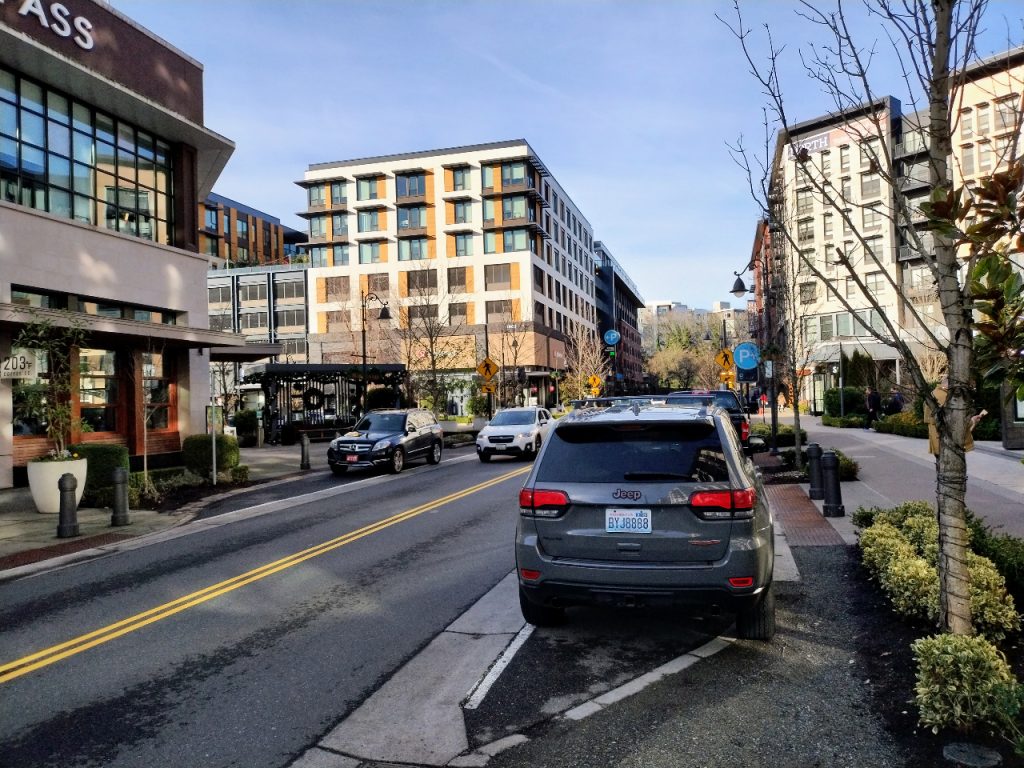
Metro would like to route the K Line on 120th, and the Kirkland City Council is on board as well. Physical improvements to curtail parking on 120th Avenue NE could potentially be funded by the K Line itself, but the City of Kirkland appears to be ready to get out ahead of it. “I think we all agree that we want to see buses back on 120th, right away, and it doesn’t need to wait for the K Line,” Kirkland Councilmember Jon Pascal said last month, expressing frustration with drivers who were parking illegally on the street.
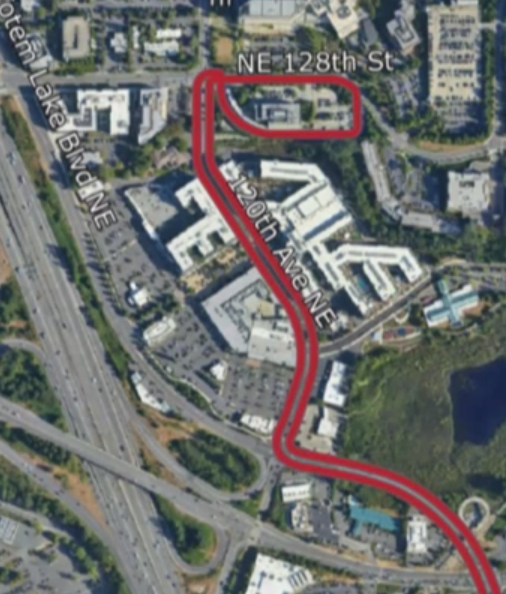
The K Line would serve both of Kirkland’s Stride BRT stations at NE 85th Street and Totem Lake, plus the Kirkland Transit Center in Moss Bay and the South Kirkland Park and Ride, which is also a major bus transfer point and will be a light rail terminus when the Issaquah to Kirkland line is finally built in the 2040s. The K Line will clearly make it much more convenient for Kirkland riders to get to Stride or light rail, so long as the ride is indeed rapid and reliable.
King County is planning a round of outreach later this summer. That will present a major opportunity to ensure that transit rider interests are centered in K Line planning and that the opportunity is not squandered to improve connections to the massive rapid transit investments the region is making.
Take Action: Metro has an online survey open through July 24 and a series of virtual open houses planned to gather public input on the RapidRide K Line.
Ryan Packer has been writing for The Urbanist since 2015, and currently reports full-time as Contributing Editor. Their beats are transportation, land use, public space, traffic safety, and obscure community meetings. Packer has also reported for other regional outlets including BikePortland, Seattle Met, and PubliCola. They live in the Capitol Hill neighborhood of Seattle.

